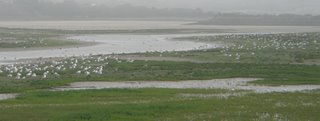Cornwall Holiday - Day Four
We started Monday morning by heading to Hayle Estuary and the RSPB reserve car park. There were literally hundreds of gulls around and a fair number of curlews in the distance. Hayle is quite a remarkable spot and we think its draw has increased as other natural resources are used or spoiled (like Stithians Reservoir which was a major disaapointment).

Back in the RSPB hide overlooking the scrapes we saw our first Greenshank, but the distance was too great for a photograph. We headed up in to Hayle itself where the estuary ends in a bank. The tide almost high leaving little wading room but we did happen across our first Whimbrel:

You can distinguish between a Wimbrel and a Curlew both in terms of the length of the beak - the Whimbrel's is shorter - and by the head markings - the Whimbrel having a prominent pale median crownstripe and darker eye stripe than the curlew.

From Hayle we headed on to Marazion and the RSPB reserve, Marazion Marshes. The sea mist was lying heavy such that you couldn't see St Michael's Mount and the visibility on the marshes was poor. We were hoping for an aquatic warbler but no such luck. Having been back and forth through the marshes, and with the tide now mostly out we decided to cross the causeway to the mount (http://www.nationaltrust.org.uk/main/w-vh/w-visits/w-findaplace/w-stmichaelsmount/). On the climb, which is acutally quite steep in places, we spotted this Chough, you can tell it by the colour (red) of its beak and the location - coastal Cornwall.

The views from the mount were excellent although I suspect the whole experience would have been much better had it been a clear day. As the there was still plenty of daylight left and with the tide still mostly out we headed back to Hayle Estuary for a second look. The view from the road, just outside the reserve itself, was as busy as usual but a bright yellow flash caught my attention. We only saw it for a minute but the Yellow Wagtail drinking from the stream in the middle-distance was a clear spot (and a first), I hope to see more and closer next year. Back then into Hayle itself, where we parked briefly to observe the feeding Little Egrets on the incoming tidal waters:


Back in the RSPB hide overlooking the scrapes we saw our first Greenshank, but the distance was too great for a photograph. We headed up in to Hayle itself where the estuary ends in a bank. The tide almost high leaving little wading room but we did happen across our first Whimbrel:

You can distinguish between a Wimbrel and a Curlew both in terms of the length of the beak - the Whimbrel's is shorter - and by the head markings - the Whimbrel having a prominent pale median crownstripe and darker eye stripe than the curlew.

From Hayle we headed on to Marazion and the RSPB reserve, Marazion Marshes. The sea mist was lying heavy such that you couldn't see St Michael's Mount and the visibility on the marshes was poor. We were hoping for an aquatic warbler but no such luck. Having been back and forth through the marshes, and with the tide now mostly out we decided to cross the causeway to the mount (http://www.nationaltrust.org.uk/main/w-vh/w-visits/w-findaplace/w-stmichaelsmount/). On the climb, which is acutally quite steep in places, we spotted this Chough, you can tell it by the colour (red) of its beak and the location - coastal Cornwall.

The views from the mount were excellent although I suspect the whole experience would have been much better had it been a clear day. As the there was still plenty of daylight left and with the tide still mostly out we headed back to Hayle Estuary for a second look. The view from the road, just outside the reserve itself, was as busy as usual but a bright yellow flash caught my attention. We only saw it for a minute but the Yellow Wagtail drinking from the stream in the middle-distance was a clear spot (and a first), I hope to see more and closer next year. Back then into Hayle itself, where we parked briefly to observe the feeding Little Egrets on the incoming tidal waters:



0 Comments:
Post a Comment
<< Home